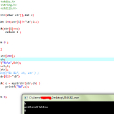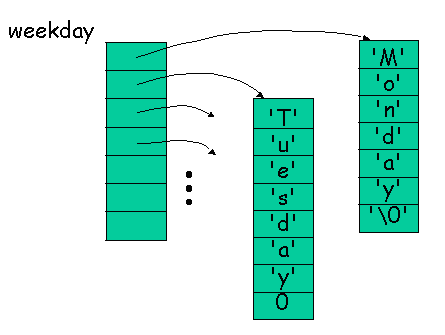
string.h
C语言标準库中一个常用的头档案,在使用到字元数组时需要使用。string .h 头档案定义了一个变数类型、一个宏和各种操作字元数组的函式。
基本介绍
- 中文名:函式string.h
- 外文名:string.h
- 性质:函式定义的头档案
- 常见错误:载入异常
- 档案大小:1.30 MB
简单介绍
C语言里面关于字元数组的函式定义的头档案,常用函式有strlen、strcmp、strcpy等等,更详细的可以到include资料夹里面查看该档案。
版本内容
string.h在c语言和c++语言中都被广泛的使用,但是具体情况不是很一样。由于传统的C++脱胎于C,所以传统C++中于C语言中对本词条的用法差不多,经过美国标準化组织修改标準化后的标準C++中,定义则是大不相同。
传统 C++
其中包含的引用头档案如下:
#include <assert.h> //设定插入点

#include <ctype.h> //字元处理
#include <errno.h> //定义错误码
#include <float.h> //浮点数处理
#include <fstream.h> //档案输入/输出
#include <iomanip.h> //参数化输入/输出
#include <iostream.h> //数据流输入/输出
#include <limits.h> //定义各种数据类型最值常量
#include <locale.h> //定义本地化函式
#include <math.h> //定义数学函式
#include <stdio.h> //定义输入/输出函式
#include <stdlib.h> //定义杂项函式及记忆体分配函式
#include <string.h> //字元串处理
#include <strstrea.h> //基于数组的输入/输出
#include <time.h> //定义关于时间的函式
#include <wchar.h> //宽字元处理及输入/输出
#include <wctype.h> //宽字元分类
标準 C++
其中包括的头档案如下(同上的不再注释)
#include <algorithm> //STL 通用算法
#include <bitset> //STL 位集容器
#include <cctype>
#include <cerrno>
#include <clocale>
#include <cmath>
#include <complex> //複数类
#include <cstdio>
#include <cstdlib>
#include <cstring>
#include <ctime>
#include <deque> //STL双端伫列容器
#include <exception> //异常处理类
#include <fstream>
#include <functional> //STL 定义运算函式(代替运算符)
#include <limits>
#include <list> //STL 线性列表容器
#include <map> //STL 映射容器
#include <iomanip>
#include <ios> //基本输入/输出支持
#include <iosfwd> //输入/输出系统使用的前置声明
#include <iostream>
#include <istream> //基本输入流
#include <ostream> //基本输出流
#include <queue> //STL 伫列容器
#include <set> //STL 集合容器
#include <sstream> //基于字元串的流
#include <stack> //STL堆叠容器
#include <stdexcept> //标準异常类
#include <streambuf> //底层输入/输出支持
#include <string> //字元串类
#include <utility> //STL 通用模板类
#include <vector> //STL动态数组容器
#include <cwchar>
#include <cwctype>
using namespace std;
C99 增加
#include <complex.h> //複数处理
#include <fenv.h> //浮点环境
#include <inttypes.h> //整数格式转换
#include <stdbool.h> //布尔环境
#include <stdint.h> //整型环境
#include <tgmath.h> //通用类型数学宏
疑问解答
c++中 string与string.h 的作用和区别
答:一般在C++的库中,对于一个旧的,也就是带“.h”扩展名的库档案(比如iostream.h),在新标準后的标準库中都有一个不带“.h”扩展名的与之相对应,区别除了后者的好多改进之外,还有一点就是后者的东东都塞进了“std”名字空间中。
但唯独string特别。
问题在于C++要兼容C的标準库,而C的标準库里碰巧也已经有一个名字叫做“string.h”的头档案,包含一些常用的C字元串处理函式。
这个头档案跟C++的string类半点关係也没有,所以 <string>并非 <string.h>的“升级版本”,他们是毫无关係的两个头档案。
c++ <string.h>中包括哪些函式?
答:常用函式如下:
strlen求字元串长度
strcmp比较2个字元串是否一样
strcat字元串连线操作
strcpy字元串拷贝操作
strncat字元串连线操作(前n个字元)
strncpy字元串拷贝操作(前n个字元)
strchr查询字串
strstr 查询子串
函式用法
下面为string.h档案中函式的详细用法,附加实例:
strcpy
函式名:strcpy
功 能:拷贝一个字元串到另一个
用 法:char *strcpy(char *destin, char *source);
程式例:
#include<stdio.h>#include<string.h>int main(void){char string[10];char*str1="abcdefghi";strcpy(string,str1);printf("%s\n",string);return 0;}strncpy
函式名:strncpy
原型:char *strncpy(char *dest, char *src,size_tn);
功能:将字元串src中最多n个字元複製到字元数组dest中(它并不像strcpy一样遇到NULL才停止複製,而是等凑够n个字元才停止複製),返回指向dest的指针。
strcat
 用strcat的结果显示
用strcat的结果显示函式名:strcat
功 能:字元串拼接函式
用 法:char *strcat(char *destin, char *source);
程式例:
#include<string.h> #include<stdio.h>void main() { char destination[25]; char*blank="",*c="C++",*Borland="Borland"; strcpy(destination,Borland); strcat(destination,blank); strcat(destination,c); printf("%s\n",destination); }strchr
函式名:strchr
功 能: 在一个串中查找给定字元的第一个匹配之处
用 法:char *strchr(char *str, char c);
程式例:
#include<string.h>#include<stdio.h>int main(void){char string[15];char*ptr,c='r';strcpy(string,"Thisisastring");ptr=strchr(string,c);if(ptr)printf("Thecharacter%cisatposition:%d\n",c,ptr-string);elseprintf("Thecharacterwasnotfound\n");return 0;}strcmp
函式名:strcmp
功 能:串比较
用 法:int strcmp(char *str1, char *str2);
看Asic码,str1>str2,返回值 > 0;两串相等,返回0
程式例:
#include<string.h>#include<stdio.h>int main(void){char*buf1="aaa",*buf2="bbb",*buf3="ccc";int ptr;ptr=strcmp(buf2,buf1);if(ptr>0)printf("buffer2isgreaterthanbuffer1\n");elseprintf("buffer2islessthanbuffer1\n");ptr=strcmp(buf2,buf3);if(ptr>0)printf("buffer2isgreaterthanbuffer3\n");elseprintf("buffer2islessthanbuffer3\n");return 0;}strnicmp
函式名:strnicmp
功 能:将一个串中的一部分与另一个串比较, 不管大小写
用 法:intstrnicmp(char *str1, char *str2, unsigned maxlen);
程式例:
#include<string.h>#include<stdio.h>int main(void){char*buf1="BBB",*buf2="bbb";int ptr;ptr=strnicmp(buf2,buf1);if(ptr>0)printf("buffer2isgreaterthanbuffer1\n");if(ptr<0)printf("buffer2islessthanbuffer1\n");if(ptr==0)printf("buffer2equalsbuffer1\n");return 0;}strlen
函式名:strlen
功能:strlen函式求的是字元串的长度,它求得方法是从字元串的首地址开始到遇到第一个'\0'停止计数,如果你只定义没有给它赋初值,这个结果是不定的,它会从字元串首地址一直记下去,直到遇到'\0'才会停止。
原型:size_tstrlen(const char *s);
#include<stdio.h>#include<string.h>int main(){int i=0;char*he="Hello,world";i=strlen(he);printf("字元串长度为%d\n",i);return 0;}运行结果:
字元串长度为11
strcspn
函式名:strcspn
功 能:在串中查找第一个给定字元集内容的段
用 法:intstrcspn(char *str1, char *str2);
程式例:
#include<stdio.h>#include<string.h>int main(void) {char*string1="1234567890";char*string2="747DC8";int length;length=strcspn(string1,string2);printf("Characterwherestringsintersectisatposition%d\n",length);return 0;}strdup
函式名:strdup
功 能:将串拷贝到新建的位置处
用 法:char *strdup(char *str);
程式例:
#include<stdio.h>#include<string.h>#include<alloc.h>int main(void){char*dup_str,*string="abcde";dup_str=strdup(string);printf("%s\n",dup_str);free(dup_str);return 0;}stricmp
函式名:stricmp
功 能:以大小写不敏感方式比较两个串
用 法:intstricmp(char *str1, char *str2);
程式例:
#include<string.h>#include<stdio.h>int main(void){char*buf1="BBB",*buf2="bbb";int ptr;ptr=stricmp(buf2,buf1);if(ptr>0)printf("buffer2isgreaterthanbuffer1\n");if(ptr<0)printf("buffer2islessthanbuffer1\n");if(ptr==0)printf("buffer2equalsbuffer1\n");return 0;}strerror
函式名:strerror
功 能:返回指向错误信息字元串的指针
用 法:char *strerror(int errnum);
程式例:
#include<stdio.h>#include<errno.h>int main(void){char*buffer;buffer=strerror(errno);printf("Error:%s\n",buffer);return 0;}strcmpi
函式名:strcmpi
功 能:将一个串与另一个比较, 不管大小写
用 法:intstrcmpi(char *str1, char *str2);
程式例:
#include<string.h>#include<stdio.h>int main(void){char*buf1="BBB",*buf2="bbb";int ptr;ptr=strcmpi(buf2,buf1);if(ptr>0)printf("buffer2 is greater than buffer1\n");if(ptr<0)printf("buffer2islessthanbuffer1\n");if(ptr==0)printf("buffer2equalsbuffer1\n");return 0;}strncmp
函式名:strncmp
功 能:串比较
用 法:intstrncmp(char *str1, char *str2, int maxlen);
程式例:
#include<string.h>#include<stdio.h>int main(void){char *buf1="aaabbb",*buf2="bbbccc",*buf3="ccc";int ptr;ptr=strncmp(buf2,buf1,3);if(ptr>0)printf("buffer2 is greater than buffer1\n");elseprintf("buffer2 is less than buffer1\n");ptr=strncmp(buf2,buf3,3);if(ptr>0)printf("buffer2isgreaterthanbuffer3\n");elseprintf("buffer2islessthanbuffer3\n");return 0;}strncpy
函式名:strncpy
功 能:串拷贝
用 法:char *strncpy(char *destin, char *source, int maxlen);
程式例:
#include<stdio.h>#include<string.h>int main(void){char string[10];char*str1="abcdefghi";strncpy(string,str1,3);string[3]='\0';printf("%s\n",string);return 0;}strnicmp
函式名:strnicmp
功 能:不注重大小写地比较两个串
用 法:int strnicmp(char *str1, char *str2, unsigned maxlen);
程式例:
#include<string.h>#include<stdio.h>int main(void){char*buf1="BBBccc",*buf2="bbbccc";int ptr;ptr=strnicmp(buf2,buf1,3);if(ptr>0)printf("buffer2isgreaterthanbuffer1\n");if(ptr<0)printf("buffer2islessthanbuffer1\n");if(ptr==0)printf("buffer2equalsbuffer1\n");return 0;}strnset
函式名:strnset
功 能:将一个字元串前n个字元都设为指定字元
用 法:char *strnset(char *str, char ch, unsigned n);
程式例:
#include<stdio.h>#include<string.h>int main(void){char*string="abcdefghijklmnopqrstuvwxyz";char letter='x';printf("stringbeforestrnset:%s\n",string);strnset(string,letter,13);printf("stringafterstrnset:%s\n",string);return 0;}strpbrk
函式名:strpbrk
功 能:在串中查找给定字元集中的字元
用 法:char *strpbrk(char *str1, char *str2);
程式例:
#include<stdio.h>#include<string.h>int main(void){char*string1="abcdefghijklmnopqrstuvwxyz";char*string2="onm";char*ptr;ptr=strpbrk(string1,string2);if(ptr)printf("strpbrkfoundfirstcharacter:%c\n",*ptr);elseprintf("strpbrkdidn'tfindcharacterinset\n");return 0;}strrchr
函式名:strrchr
功 能:在串中查找指定字元的最后一个出现
用 法:char *strrchr(char *str, char c);
程式例:
#include<string.h>#include<stdio.h>int main(void){char string[15];char*ptr,c='r';strcpy(string,"Thisisastring");ptr=strrchr(string,c);if(ptr)printf("Thecharacter%cisatposition:%d\n",c,ptr-string);elseprintf("Thecharacterwasnotfound\n");return 0;}strrev
函式名:strrev
功 能:串倒转
用 法:char *strrev(char *str);
程式例:
#include<string.h>#include<stdio.h>int main(void){char*forward="string";printf("Beforestrrev():%s\n",forward);strrev(forward);printf("Afterstrrev():%s\n",forward);return 0;}strspn
函式名:strspn
功 能:返回字元串中第一个不在指定字元串中出现的字元下标
用 法:int strspn(char *str1, char *str2);
程式例:
#include<stdio.h>#include<string.h>#include<alloc.h>int main(void){char*string1="1234567890";char*string2="123DC8";int length;length=strspn(string1,string2);printf("Characterwherestringsdifferisatposition%d\n",length);return 0;}strstr
函式名:strstr
功 能:在串中查找指定字元串的第一次出现
用 法:char *strstr(char *str1, char *str2);
程式例:
#include<stdio.h>#include<string.h>int main(void){char*str1="BorlandInternational",*str2="nation",*ptr;ptr=strstr(str1,str2);printf("Thesubstringis:%s\n",ptr);return 0;}strtod
函式名:strtod
功 能:将字元串转换为double型值
用 法:double strtod(char *str, char **endptr);
程式例:
#include<stdio.h>#include<stdlib.h>int main(void){char input[80],*endptr;double value;printf("Enterafloatingpointnumber:");gets(input);value=strtod(input,&endptr);printf("Thestringis%sthenumberis%lf\n",input,value);return 0;}strtok
函式名:strtok
功 能:查找由在第二个串中指定的分界符分隔开的单词
用 法:char *strtok(char *str1, char *str2);
程式例:
#include<string.h>#include<stdio.h>int main(void){char input[16]="abc,d";char*p;/*strtokplacesaNULLterminatorinfrontofthetoken,iffound*/p=strtok(input,",");if(p) printf("%s\n",p);/*AsecondcalltostrtokusingaNULLasthefirstparameterreturnsapointertothecharacterfollowingthetoken*/p=strtok(NULL,",");if(p) printf("%s\n",p);return 0;}strtol
函式名:strtol
功 能:将串转换为长整数
用 法:long strtol(char *str, char **endptr, int base);
程式例:
#include<stdlib.h>#include<stdio.h>int main(void){char*string="87654321",*endptr;long lnumber;/*strtolconvertsstringtolonginteger*/lnumber=strtol(string,&endptr,10);printf("string=%slong=%ld\n",string,lnumber);return 0;}strupr
函式名:strupr
功 能:将串中的小写字母转换为大写字母
用 法:char *strupr(char *str);
程式例:
#include<stdio.h>#include<string.h>int main(void){char string[]="abcdefghijklmnopqrstuvwxyz",*ptr;//定义为数组才能修改/*convertsstringtouppercasecharacters*/ptr=strupr(string);printf("%s\n",ptr);return 0;}swab
函式名:swab
功 能:交换位元组
用 法:void swab (char *from, char *to, int nbytes);
程式例:
#include<stdlib.h>#include<stdio.h>#include<string.h>char source[15]="rFnakoBlrnad";char target[15];int main(void){swab(source,target,strlen(source));printf("Thisistarget:%s\n",target);return 0;}原型:extern char *strstr(char *haystack, char *needle);
*所在头档案:#include <string.h>
*功能:从字元串haystack中寻找needle第一次出现的位置(不比较结束符NULL)。
*说明:返回指向第一次出现needle位置的指针,如果没找到则返回NULL。
 海之美文新闻资讯
海之美文新闻资讯